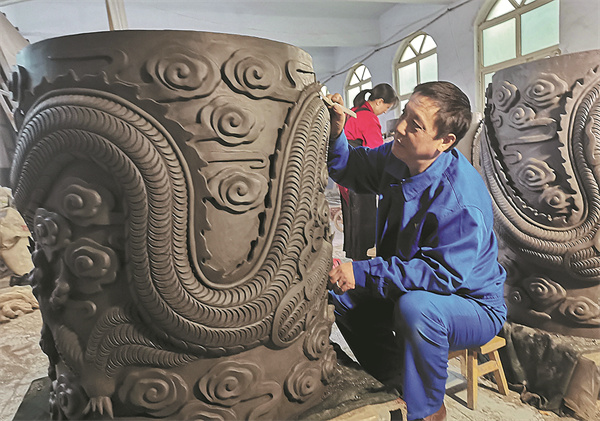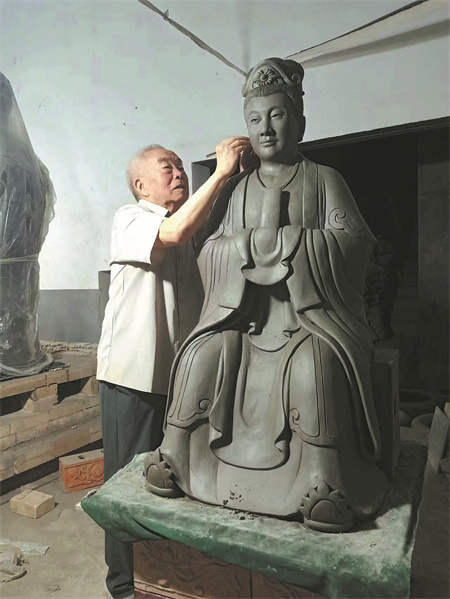Artisans Continue to Raise the Roof

Cui demonstrates the craft to apprentices at a factory.[Photo provided to China Daily]
The craft behind the glazed tiles that adorn China's iconic architecture came close to extinction, but through the concerted efforts of a few dedicated people, is now thriving once more, Wang Qian and Sun Ruisheng in Taiyuan report.
One iconic facet of China's historic architecture is its roofs and eaves, which are mainly covered in tiles glazed in green, yellow and blue.
Behind these ceramic tiles and sculptures is a craft passed down over thousands of years, and which is still practiced in Yangcheng county, Shanxi province, today.
According to Glazed Works in Shanxi Province published by the Cultural Relics Press, the glazed tiles and other components made in Shanxi can be found in structures at the Forbidden City, also known as the Palace Museum, and the Ming Tombs in Beijing.
In ancient times, because they were difficult to obtain, ordinary people regarded these glazed tiles as being more precious than jade.
The craft is not only revered in China. Such glazed items are surfacing in the collections of many museums abroad, such as The Metropolitan Museum of Art in New York City, the Louvre Museum in Paris and the British Museum in London.
In 2010 and 2011, the Princeton University Art Museum held Green, Amber, Cream: Forgotten Art of a Ceramic Workshop in Shanxi, China introducing the almost forgotten art. Behind the exhibits were the Qiao family who made glazed ceramic architectural tiles and religious sculptures as far back as the Yuan Dynasty (1271-1368) and were especially prolific during the Ming Dynasty (1368-1644).

There are dozens of factories in the county producing glazed ceramic tiles and sculptures.[Photo provided to China Daily]
Chen Wanli, a noted ceramic expert, once said the Qiao family was undoubtedly an important school in the history of Shanxi's glaze craft sector. There is clearly a family influence demonstrated in the works unearthed, according to Chen.
Architectural glazed tiles were used to decorate imperial palaces in China as far back in history as the Northern Wei Dynasty (386-534). However, it wasn't until the Ming and Qing (1644-1911) dynasties that the use of architectural glazed tiles became more widespread and enjoyed its peak period. It was common to find tiles modeled after auspicious beasts and creatures decorating ridges and eaves, showing off the prominence and scale of the building.
For Cui Shulin, the 77-year-old inheritor of the Qiao family craft, the technique hasn't changed in more than 1,600 years and has been revived in Yangcheng, creating employment opportunities in the local community.
In the county, there are 32 factories producing glazed ceramic tiles and sculptures with an annual production value reaching 560 million yuan ($83 million) last year, according to Shi Guoping, head of the Yangcheng County Building Ceramic Association. In 2008, the craft was recognized as a national cultural heritage.

A set of Buddhist figures believed to be from the Qiao family workshop in Yangcheng county, Shanxi province, and now in the collection of The Metropolitan Museum of Art in New York City.[Photo provided to China Daily]
"The technique follows those employed by the Qiao family," Cui says, adding that a simple sculpture requires more than 10 days work and goes through over 20 steps, such as molding and two firings — one for the clay and the other for the application of the glaze.
As a traditional building material used throughout the history of traditional Chinese architecture, glazed tile is molded from clay and fired. The colors of the glaze are yellow, green, black and blue. Because the glazed surface is smooth and does not absorb water, it is a good way of protecting wooden buildings from the weather.
Although the skill is widely practiced today, Cui knows how close the craft came to disappearing on the nation's march to progress.
Formerly running a family business, the Qiao craftsmen carefully guarded the technical skills and production methods, which were passed down from generation to generation among male family members. The tradition was broken in 1955 when a State-owned ceramic factory was established in Yangcheng, hiring Qiao Chengxian as technician. Qiao taught the craft to people outside his family, which included Cui.
During the "cultural revolution" (1966-76), like many folk arts that were regarded as old and outdated, the craft was nearly abandoned. In 1981, the local cultural center invited Cui to revive the glazing technique.
Building a 4-cubic-meter kiln in Houzeyao, a village in Yangcheng, Cui recruited Cui Ruxia and Ma Ximei to help him bring the forgotten craft back to life.

Cui Shulin, the 77-year-old inheritor of the Qiao family glazing craft, gives the final touches to an earthenware sculpture at a studio in Yangcheng.[Photo provided to China Daily]
After thousands of tests over two years, Cui Shulin finally succeeded in restoring the craft and perfecting its glaze formula. In 1985, he raised 100,000 yuan to set up a factory to manufacture glazed ceramic tiles and sculptures.
The low-fired earthenware with lead-based glazes from the factory was used to decorate the roofs and walls of the temples, pagodas and modern buildings across the country.
In 2013, Cui Shulin established a studio to study and inherit the Qiao-style craft. He hopes to build it into an intangible cultural heritage teaching center that integrates study, promotional work, exhibitions and cultural exchanges.
In 2019, an art museum focusing on the craft was built in Houzeyao village, and local authorities carried out a protection plan for 11 kiln sites that date back to Song Dynasty (960-1279).
Shi says that, in the future, there will be collaboration projects in architectural protection and renovation with the Palace Museum in Beijing and the Shenyang Palace Museum in Liaoning province.
"We are also exploring innovations in design in order to make the products relevant to modern lifestyles," Shi says, adding that family decoration and collection as artworks will be a new direction for the industry.